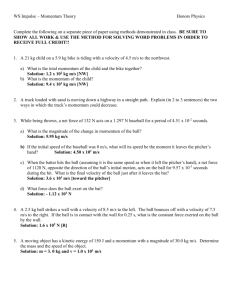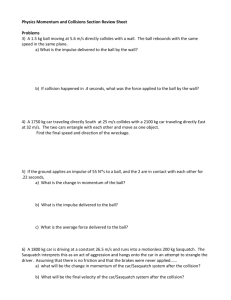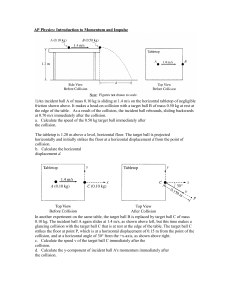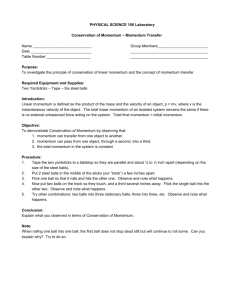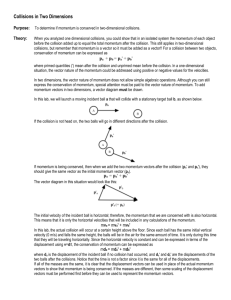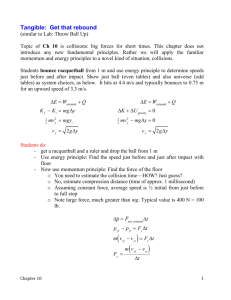2- D Momentum Collision Lab
advertisement
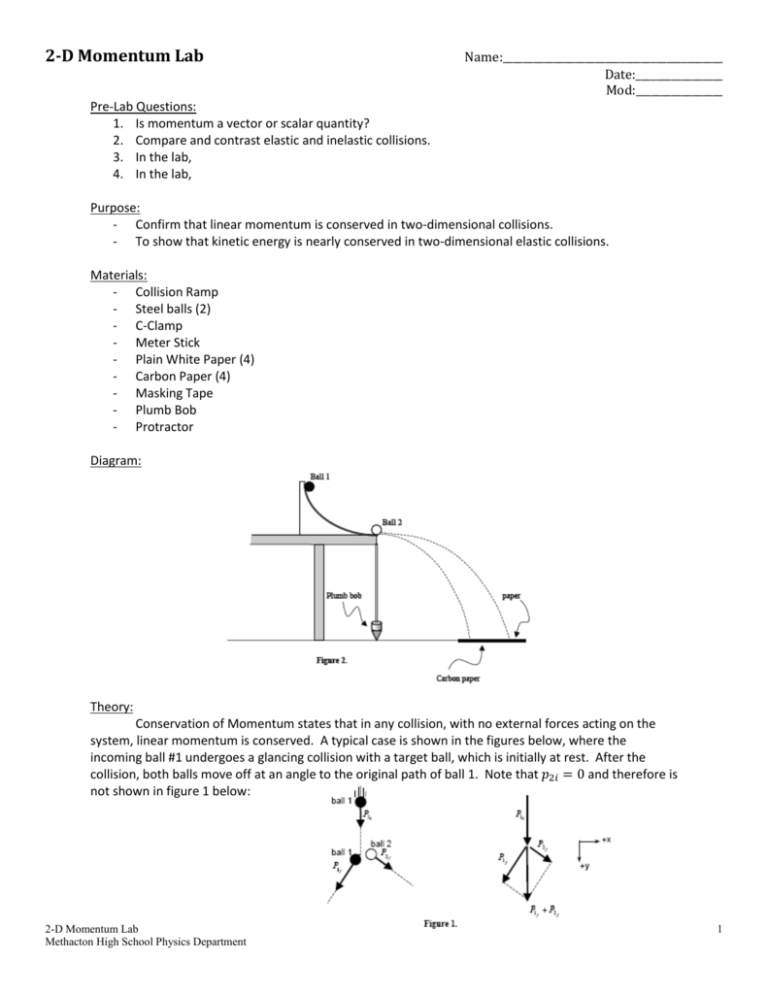
2-D Momentum Lab Name:___________________________________________ Date:_________________ Mod:_________________ Pre-Lab Questions: 1. Is momentum a vector or scalar quantity? 2. Compare and contrast elastic and inelastic collisions. 3. In the lab, 4. In the lab, Purpose: - Confirm that linear momentum is conserved in two-dimensional collisions. - To show that kinetic energy is nearly conserved in two-dimensional elastic collisions. Materials: - Collision Ramp - Steel balls (2) - C-Clamp - Meter Stick - Plain White Paper (4) - Carbon Paper (4) - Masking Tape - Plumb Bob - Protractor Diagram: Theory: Conservation of Momentum states that in any collision, with no external forces acting on the system, linear momentum is conserved. A typical case is shown in the figures below, where the incoming ball #1 undergoes a glancing collision with a target ball, which is initially at rest. After the collision, both balls move off at an angle to the original path of ball 1. Note that 𝑝2𝑖 = 0 and therefore is not shown in figure 1 below: 2-D Momentum Lab Methacton High School Physics Department 1 Note that the vector sum of the final momenta is equal to the initial momentum. In the example drawn above, the collision occurs in a plane although the method could be used to analyze a similar three dimensional collision. Applying conservation of linear momentum to the situation described above, using the shown coordinate system, yields: 𝑝1𝑥 𝑖 = 𝑝1𝑥 𝑓 + 𝑝2𝑥 𝑓 → 𝑚1 𝑣1𝑥 𝑖 = 𝑚1 𝑣1𝑥 𝑓 + 𝑚2 𝑣2𝑥 𝑓 As both of the balls fall at the same rate and strike the paper at the same time, the horizontal distance they move will be proportional to the velocity of the balls in the plane of the floor. Multiplying this distance by the mass of each ball will yield a number proportional to the momentum. If the masses are equal than 𝑚1 = 𝑚2 𝑣1𝑥 𝑖 = 𝑣1𝑥 𝑓 + 𝑣2𝑥 𝑓 If the time of fall is the same for all the objects then we can also determine our conservation by 𝑑1𝑖 = 𝑑1𝑓 + 𝑑2𝑓 Procedure: 1. The collision ramp should be securely fastened to the edge of the lab table. Adjust the target ball support so that the centers of both balls lie in a horizontal plane when they collide. 2. Tape you’re the four pieces of white paper together to make a large rectangle and place it on the floor under the point of collision. 3. Place the incident ball on the track and release from a height to make sure it will hit the paper. Once the height is found, mark that location as this will be the location where the ball should be released each time during the experiment. 4. Place the target ball on the set screw and release incident ball to determine if both balls will strike the paper after collision. 5. Adjust the paper accordingly then tape it to the floor so it does not move. Use the plumb bob to locate the region directly beneath the collision site of the two balls and mark it. 6. Place the carbon paper on the white paper with the carbon side facing down. Do not tape the carbon paper down to the floor. Allow the incident ball to roll down the track and strike the paper by itself five times. 7. Place the target ball on the set screw and allow the incident ball to strike it. Repeat five times. 8. Remove the carbon paper and draw a line using the meter stick from your reference point that was found using the plumb bob in step #5 to the average of the five dots at each location. Measure the angle each mass traveled from the original line of the incident ball and record. 9. The first set of dots is the incident ball alone which will represent 𝑑1𝑥 𝑖 measure this distance and record. Then measure each of the final set of dots after collision representing 𝑑1𝑓 𝑎𝑛𝑑 𝑑2𝑓 record. 10. Calculate the time of flight for all objects at this height. This can be found using the case one equation of a projectile and the time of flight. 2-D Momentum Lab Methacton High School Physics Department 2 11. Determine 𝑣1𝑥 𝑖 , 𝑣1𝑓 𝑎𝑛𝑑 𝑣2𝑓 using the equations below and the time of flight of the balls. a. 𝑣1𝑥 𝑖 = 𝑑1𝑖 ÷ 𝑡 b. 𝑣1𝑓 = 𝑑1𝑓 ÷ 𝑡 c. 𝑣2𝑓 = 𝑑2𝑓 ÷ 𝑡 12. Determine if Momentum is conserved by using the relationship found below: a. 𝑣1𝑥 𝑖 = 𝑣1𝑥 𝑓 + 𝑣2𝑥 𝑓 Data Table: 𝑑1𝑥 𝑖 (m) θ of Ball 1 after collision 𝑑1𝑓 (m) Time of Flight (s) 𝑣1𝑓 (m/s) 𝑣1𝑥 𝑓 (m/s) 𝑑2𝑥 𝑖 (m) θ of Ball 2 after collision 𝑑2𝑓 (m) Time of Flight (s) 𝑣2𝑓 (m/s) 𝑣2𝑥 𝑓 (m/s) 0m(at rest) Post-Lab Questions: Answer the following questions by writing in complete sentences. If the question asks you calculate or solve, show your work and circle the final answer with the correct units. 1. Show the calculations for all the variables listed in the data table, except for the angles. 2. Show the calculation to determine if the momentum was conserved through the equation 𝑣1𝑥 𝑖 = 𝑣1𝑥 𝑓 + 𝑣2𝑥 𝑓 3. Draw a scale momentum vector diagram to show how the momentum triangle is obtained. What does the diagram show? 2-D Momentum Lab Methacton High School Physics Department 3


